Guard of honour
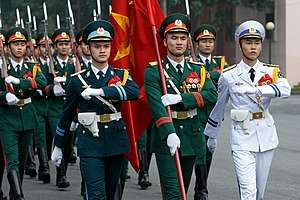
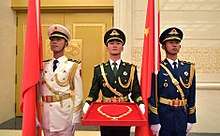
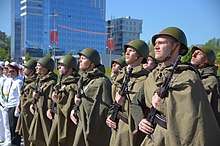

A guard of honour (en-GB), guard of honor (en-US), also honour guard (en-GB), honor guard (en-US), also ceremonial guard, is a guard, usually military in nature, appointed to receive or guard a head of state or other dignitary, the fallen in war, or to attend at state ceremonials, especially funerals. In military weddings, especially those of commissioned officers, a guard, composed usually of service members of the same branch, form the Saber arch. In principle any military unit could act as a guard of honour. However, in some countries certain units are specially designated for guard of honour duty.
Guards of Honour also serve in the civilian world for fallen police officers and other civil servants. Certain religious bodies, especially Churches of the Anglican Communion and the Methodist movement, have the tradition of an Honour Guard at the funeral of an ordained elder, in which all other ordained elders present "guard the line" between the door of the church and the grave, or hearse if the deceased is to be buried elsewhere or cremated.[1] The practice of providing a guard of honour as a mark of respect also occurs in sports, especially throughout the Commonwealth of Nations.
Military
Africa
Algeria
The Algerian Republican Guard (Arabic: الحرس الجمهوري الجزائري, French: Garde républicaine algérienne), is a mainly ceremonial military corps of the Algerian army which is composed of 6,000 troops.
Egypt
The Egyptian Republican Guard is a Division level unit in the Egyptian Army which has the responsibility of defending the President of Egypt, as well as major presidential and national institutions.
Nigeria
The members of the Nigerian Presidential Guard Brigade are elite Nigerian soldiers which guards the residence of the President of the Federal Republic and his guests as well as perform ceremonial duties. It is similar to the American Secret Service.
Senegal
The Red Guard of Senegal is a Senegalese Gendarmerie unit that is responsible for maintaining the security of the President of Senegal. It is similar to the ceremonial elements in the French Republican Guard. The unit's uniform is derived from the French colonial Spahi.
South Africa
The guard of honour unit in South Africa was the State Presidents Guard (Staatspresidentseenheid) until 1990.[2] The unit has since been replaced by the National Ceremonial Guard in the South African National Defence Force.
Gallery of Africa
.jpg)

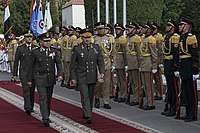
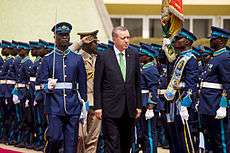 A Ghana Air Force Guard of Honour.
A Ghana Air Force Guard of Honour. Russian President Dmitry Medvedev inspecting the Presidential Guard Brigade during his visit to Abuja in June 2009.
Russian President Dmitry Medvedev inspecting the Presidential Guard Brigade during his visit to Abuja in June 2009.- The National Ceremonial Guard at the opening of 17th World Festival of Youth and Students.
.jpg) The Senegalese Red Guard during the inauguration of Macky Sall.
The Senegalese Red Guard during the inauguration of Macky Sall.
North America
Canada
The Canadian guard of honour is formed from members of the Ceremonial Guard, an ad hoc unit drawn from all branches of the Canadian Forces (CF). Although the unit's members are derived from a variety of military units, the Ceremonial Guard uses similar uniforms to Canada's two Foot Guards regiments as a reflection of their traditional connection with those regiments.[3] The unit comprises 400 people, including a Foot Guard company and the Band of the Ceremonial Guard. The Ceremonial Guard typically execute public duties in Ottawa during the summer months of the year. The Guard is mounted on dates such as Canada Day and Remembrance Day, inspected by the most senior dignitary in attendance. They may also be formed for repatriation ceremonies for fallen soldiers returning from combat. Public duties in Ottawa were performed by the Canadian Guards before the unit's disbandment in 1970.[4]
Prior to 2007, membership with the Ceremonial Guard was restricted to the Foot Guards of the Canadian Army. The Household Division of the Canadian Army had traditionally performed ceremonial duties, such as guard mounting or Trooping the Colour. The Household Division consists of two regiments of Foot Guards (the Canadian Grenadier Guards and the Governor General's Foot Guards) as well as one cavalry regiment (the Governor General's Horse Guards). Several other Canadian Army regimental units have also performed guard of honour duties, including the Royal 22nd Regiment, these units are active in events such as royal and state visits, national and provincial celebrations, state, military and civil funerals and ceremonies related to the work of the entire Armed Forces. Alongside these are detachments made up for ceremonial duties from both the Royal Canadian Navy and the Royal Canadian Air Force.
Cuba
The Ceremonial Unit of the Cuban Revolutionary Armed Forces provided honours for the Communist Party of Cuba, the Government of Cuba, and the Cuban Revolutionary Armed Forces. The main purpose of the military unit is the performance of the changing of the guard every half an hour at the José Marti Mausoleum in Santiago de Cuba.
Mexico
The Honour Guard in Mexico consists of members selected from the Navy, Army or Air Force, and report to the Secretariats of National Defense and the Navy, while the Estado Mayor Presidencial maintains, through the Army Presidential Guards Corps, a dedicated guards brigade. Some of their duties include protection of the Mexican flag in Zocalo, and the raising and lowering of it, as well as providing ceremonial guards during state visits to Mexico. There are also those selected from other organizations, such as historic societies, schools, sports centers, celebrities, etc., but these are for national holiday events within the country. Escolta de la bandera or Escolta de guerra or Escolta de honores or simply La escolta is the term in Spanish for color guards and flag parties.
United States
Each uniformed service branch in the U.S. Armed Forces has its own official honour guard: Army,[5] Marines,[6] Navy,[7] Air Force,[8] and Coast Guard.[9] Most state national guard units have a ceremonial guard as well. The official honour guard of every branch is located in the National Capital Region, though nearly every military installation will have its own honour guard for local ceremonies and events. The honour guard units in National Capital Region represent the military as a whole and the United States as a nation, and perform numerous ceremonies on behalf of the President of the United States. Since World War II, The Old Guard has served as the official Army Honor Guard and escort to the President, and it also provides security for Washington, D.C., in time of national emergency or civil disturbance.[10]
Arlington National Cemetery's Tomb of the Unknowns is guarded by members of the U.S. 3rd Infantry Regiment (The Old Guard).[11]
Many local, state/provincial, national and federal public safety agencies maintain Honour Guards, Pipes & Drums and Buglers, including fire departments, law enforcement agencies, emergency medical services, and search and rescue, who typically use adaptations of military honour guards, and honour those who die in the line of duty (LODD-Line of Duty Death), off-duty but still on the job, and retirees, as well as participating in support of other agencies, and parades. Some Law Enforcement agencies are able to maintain a Rifle Team for 'three volley' salutes. Most, even those within major career paid agencies, are not paid for performing and preparing for the honor guard duty.
Gallery of North America
.jpg) Inspection of the guard of honour, made up of the Governor General's Foot Guards during the Duke and Duchess of Cambridge's 2011 royal tour of Canada.
Inspection of the guard of honour, made up of the Governor General's Foot Guards during the Duke and Duchess of Cambridge's 2011 royal tour of Canada.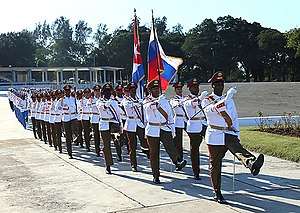 The Cuban ceremonial unit in 2015.
The Cuban ceremonial unit in 2015.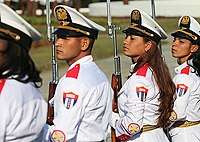 Female members of the unit
Female members of the unit.jpg) Canadian Prime Minister Justin Trudeau inspecting the Mexican guard of honor during his visit to Mexico in 2016.
Canadian Prime Minister Justin Trudeau inspecting the Mexican guard of honor during his visit to Mexico in 2016.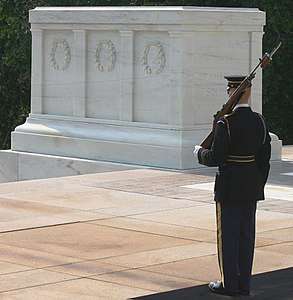 A sentry at the Tomb of the Unknown Soldier at Arlington National Cemetery.
A sentry at the Tomb of the Unknown Soldier at Arlington National Cemetery. Israeli Prime Minister Ehud Barak (right) is escorted by Commander of Troops Col. Thomas M. Jordan (center), U.S. Army, and Secretary of Defense William S. Cohen (left) as Barak inspects the joint honor guard during an arrival ceremony at the Pentagon on July 16, 1999.
Israeli Prime Minister Ehud Barak (right) is escorted by Commander of Troops Col. Thomas M. Jordan (center), U.S. Army, and Secretary of Defense William S. Cohen (left) as Barak inspects the joint honor guard during an arrival ceremony at the Pentagon on July 16, 1999.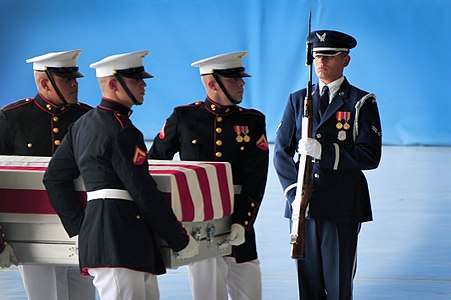 A ceremonial guardsman from the United States Air Force Honor Guard presents arms to honor U.S. Foreign Service members killed during attacks to the U.S. consulate 2012, in Benghazi, Libya.
A ceremonial guardsman from the United States Air Force Honor Guard presents arms to honor U.S. Foreign Service members killed during attacks to the U.S. consulate 2012, in Benghazi, Libya.
South America
Argentina
Regiment of Mounted Grenadiers (Argentina). Still serving as part of the Argentine Army, they are the presidential guard and ceremonial companions. Two unmounted grenadiers are stationed in front of the Pink House as a symbol of the ceremonial and honour guard.
Brazil
The Brazilian armed forces and police have several troops for ceremonial usages. The most important of them is the Brazilian president's honour guard. It is composed of the 1st Guards Cavalry Regiment (1o Regimento de Cavalaria de Guardas – RCG, in Portuguese) – "Independence Dragoons", the Presidential Guard Battalion (Batalhão da Guarda Presidencial – BGP, in Portuguese) and the Cayenne Battery.
Colombia
The 37th Infantry Presidential Guard Battalion, composed of five companies, a historical company and one artillery battery plus a military band, a fanfare trumpet section and Corps of Drums, is the President of Colombia's honour guard service regiment under the National Army of Colombia. It is stationed at the Casa de Nariño in Bogota and carries the traditions of Simon Bolivar's infantry guards company raised in the midst of the Spanish American wars of independence in 1815.[12]
Venezuela
The Presidential Honor Guard Brigade is the joint service military unit mandated to ensure the immediate security of the President of Venezuela and his First Family and for the performance of public duties in the most important places in the country. The most distant antecedents of the Presidential Honor Guard go back to the Hussars Troop of Simon Bolivar, of the Venezuelan War of Independence and of the larger Spanish American wars of independence, raised in June 1815 and part of a more bigger guards brigade targeted for the immediate security of the Liberator, and the early 20th century 1st Cavalry Regiment "Ambrosio Plaza" that until the 1950s, albelt reduced to squadron size, provided the ceremonial security of the President and was modeled on the Prussian horse guards units of the late 19th century. The modern brigade serves as a ceremonial escort to the President of Venezuela at Miraflores Palace and attends all state arrival ceremonies conducted there, as well as providing security for the palace complex. The brigade also provides honor guards (i) at the Tomb of the Unknown Soldier at Carabobo Field, Carabobo commemorating the memory of national heroes and the fallen of the Battle of Carabobo of 1821, (ii) at the Montana Barracks in Caracas in memory of the late Hugo Chávez; and (iii) at the National Pantheon in Caracas in memory of Bolívar and other national heroes buried there. The brigade also performs public duties functions as required. Brigade personnel come from all branches of the National Bolivarian Armed Forces of Venezuela and public security services. The brigade is commanded by a general or flag officer and includes a Presidential mounted escort of platoon or troop size.
Aside from the PHGB, there are two foot guards battalions in the NBAF, each also tasked with forming guards of honour and public duties:
- Caracas Foot Guards Battalion of the Ministry of Defense
- Brigadier Daniel Florence O'Leary Headquarters and HQ Services Foot Guards Battalion of the Venezuelan Army Headquarters
Gallery of South America
- Mounted Grenadiers of "San Martín", for the Russian Prime Minister Mikhail Fradkov's arrival, San Martín Square, Buenos Aires.
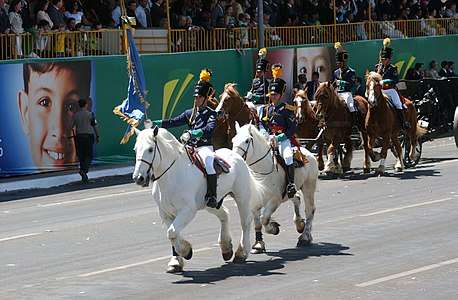
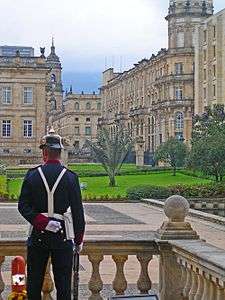 A Soldier of the Military Engineers Battalion of the Presidential Guard.
A Soldier of the Military Engineers Battalion of the Presidential Guard.
Asia
Armenia
Honour guards from the Armed Forces of Armenia are provided by the Honour Guard Battalion of the Ministry of Defense of Armenia (Հայաստանի Պաշտպանության նախարարության Պատվո պահքի գումարտակը, Hayastani Pashtpanut’yan nakhararut’yan Patvo pahk’i gumartakyl), which is stationed at the defense ministry's headquarters in Yerevan. The battalion was founded on the basis of the Honour Guard Unit of the 7th Guards Army of the Red Army. The Armenian Police also have their own Honour Guard Battalion, which serves under the auspices of the Yerevan police headquarters.
Azerbaijan
In Azerbaijan, military honor guards during state visits are provided by the Azerbaijani National Guard. A tri-service honor guard subordinate to the defense ministry is also available.
China (People's Republic of China)
Honour guards, as known as Combined Honour Guard of the People's Liberation Army, are provided by the Beijing Capital Garrison Command in Beijing, under the Central Theater Command and reporting directly to the General Staff. They marched as the first battalion in the military parade of the 35th, 50th, and 60th anniversaries of the People's Republic of China. They are often on parades led by a color guard detail carrying the PLA flag.
India
In India, the Tri-Services Guard of Honour is made up of men or women drawn from three services of the Indian military: the Indian Army, Indian Air Force, and Indian Navy. It is based at New Delhi and is of company size, present only during state visits. In January 2015, during Barack Obama's state visit to India, Wing Commander Pooja Thakur became the first female officer to lead the guard of honour for a foreign leader.[13]
Indonesia
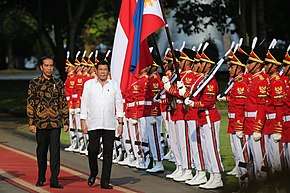
In Indonesia, the unit institutionally intended to act as a honour guard for the President of Indonesia and towards foreign state leaders or officials visiting Indonesia is the Paspampres which is conducted at the national palaces of Indonesia (Merdeka Palace or Bogor Palace). The Paspampres forms as a special branch of the Indonesian National Armed Forces tasked for protective security duties towards the VVIP. This special joint service command, other than being responsible for security of the President and Vice President of Indonesia also conducts Public duties, Quarter guard, Ceremonial, and Escort tasks for the national official residences. Public duties for the Merdeka Palace during state visits and holidays are tasked to the personnel of the "State Protocol Escort Battalion" (Batalyon Pengawalan Protokol Negara abbreviated "Yonwalprotneg"), a unit from each of the groups of the Paspampres consisting of chosen Military policemen.
During the ceremony commemorating the independence day of Indonesia in the Merdeka Palace at every 17 August, honour guards which line-up at the palace yard during the ceremony are part of the combined-forces honour guard which includes the Army, Navy, Air Force, and Police force. During this occasion, the Paspampres "A" Group acts as the honour guard for the national flag where they join marching with the Paskibraka. The same format is seen in other parts of the country during the ceremony for commemorating the independence day of Indonesia with the honor guards tasked from local territorial Military or Police units in Provincial, city or regency level.
Japan
The 302nd JGSDF Security Company (Japanese: 第302保安警務中隊) is a police force unit under the direct control of the Eastern Army located in the Ichigaya garrison. When foreign leaders make state visit to Tokyo, The Special Ceremonial Detachment from the company is assembled at the Tokyo Imperial Palace or the Prime Minister's Official Residence to take part in the welcoming ceremony. The 115-strong personnel company is organized into three platoons, with each consisting of three honor guard squads. In wartime situations, the company serves as a military police unit.
Kyrgyzstan
The National Guard of Kyrgyzstan carries out official representative functions on behalf of the Armed Forces of the Kyrgyz Republic. The guard of honor is formed from the 701st Military Unit of the National Guard. The National Guard stands at attention at the National Flagpole on Ala-Too Square in Bishkek, and has been performing the changing of the guard ceremony every hour since 16 August 1998.[14][15]
Malaysia
The guard of honour in Malaysia usually consists of the 1st Battalion, Royal Malay Regiment, which performs most ceremonial duties in Malaysia, such as Heroes' Day, visitation of diplomats and state leaders, National Day, guard duties at the Royal Palace of Malaysia, and many more, in the national level. The RMR also mounts the guard during state visits to the Ministry of Defense.
State level guards of honour are mounted by the following units aside from the Royal Malay Regiment, which is also the guard of honour for the states of Kedah, Perak, Selangor and Pahang:
- Royal Ranger Regiment - Perlis
- Royal Armoured Corps - Terengganu
- Royal Johor Military Force - Johor (the only state level defense formation and one of Malaysia's oldest military units)
- Royal Artillery Regiment - Kelantan
- Royal Regiment of Engineers - Perak
- Royal Signals Regiment - Negeri Sembilan
Units of the Royal Malaysia Police in Melaka, Penang, Sabah and Sarawak, as well as the Royal Malay Regiment and the Royal Rangers, mount guards of honour of the governors of these states. Guard of honour units are also found in the Royal Malaysia Police, The People's Volunteer Corps, the Fire and Rescue Department, and the Malaysia Civil Defence Force.
Honour guards units of the Royal Malaysian Navy (RMN Honour Guard Battalion, Lumut) and the Royal Malaysian Air Force (RMAF Honour Guard Battalion or the RMAF College) are mounted in the presence of the Sultan of Selangor and the Sultan of Pahang, respectively, in events where each of the two service branches are involved. Visits to the MoD building by naval and air general and flag officers are also accompanied by the guard of honour units of these services.
Nepal
In Nepal, the Guard of honour is formed from special troops from Nepalese Army. It is mainly given to the President of Nepal and the Prime Minister of Nepal. Foreign Heads of State also receives the Guard of Honour. Formerly, Guard of honour were given in Tribhuwan International Airport premises but since 2018, Government of Nepal changed the venue to Tundikhel. The first foreign state head to receive the Guard of honour at Tundikhel was Pakistan Prime Minister Shahid Khaqan Abbasi during his visits to Nepal in March 2018.
Pakistan
In Pakistan, the guard of honour is provided by men drawn from three services of the Pakistan Armed Forces: The Pakistan Army, Pakistan Air Force, and the Pakistan Navy. A tri-service guard of honor company is stationed in Islamabad, the national capital, for services in state visits and important national holidays.
Philippines
The Presidential Security Group provide honour guard services to the President of the Philippines in Malacañang Palace, especially during state visits to the country. The PSG is the only presidential guard service in Asia that is composed of men and women from the various uniformed organizations of the Philippines: the Armed Forces of the Philippines, the Philippine National Police, the Bureau of Fire Protection and the Philippine Coast Guard.
The AFP has 5 designated honour guard battalions mandated for public duties for events concerning the Armed Forces. They are:
- General Headquarters Security & Escort Battalion, AFP General Headquarters and Headquarters Service Command
- Security and Escort Battalion, Philippine Army
- Headquarters Philippine Navy & Headquarters Support Group, Philippine Navy
- Marine Security and Escort Group, Philippine Marine Corps
- Air Force Special Security Group, Philippine Air Force
Honour Guard units are also present in the PNP and the PCG, and are mounted on important occasions of these two services.
Singapore
The Guards-of-Honour (GOH) of Singapore are specially formed from all three services of the Singapore Armed Forces (SAF), namely, the Singapore Army (usually comprising personnel from the sole SAF Commando Formation unit, the 1st Commando Battalion), the Republic of Singapore Navy (RSN) and the Republic of Singapore Air Force (RSAF), together with the Singapore Police Force (SPF), which are positioned at the forefront of major parades and significant state events, such as the country's National Day on 9 August. They are dressed in ceremonial attire (known as the No. 1 uniform), which, based on the unit's origin (the sole exception being the Navy), have various colours imbued on a thin strip running down the outer-sides of the pants (red for the Army, light-blue for the Air Force and black for the Police) and different and unique badges, medals, awards and buttons, and will be equipped with SAR-21 assault rifles which have bayonets attached to them. These GOH units will typically be contrasted by at least one or more contingents of their fellow troops and men in their regular uniform (the No. 4 uniform for the SAF units and the No. 3 uniform for the SPF unit).
For state-visits and other important ceremonial duties within the Istana compounds, the guard-of-honour group that is formed and mounted is provided by personnel from the Singapore Armed Forces Military Police Command.
South Korea
During the Joseon Dynasty, the role of guards of honour taken up by the Sumunjang, who reported directly to the Emperor and the Imperial Family with administrative responsibility to the Minister of Defense as part of the armed forces of the state.[16]
South Korea today operates several guards of honour companies under the Republic of Korea Armed Forces - one each from the Republic of Korea Army, Republic of Korea Navy, Republic of Korea Air Force and Republic of Korea Marine Corps, along with a traditional honour guard unit that is made up of soldiers from the 3rd Infantry Division. The traditional guard in particular was founded in 1991 after president Roh Tae-woo reviewed the Old Guard Fife and Drum Corps and the Commander-in-Chief's Guard of the 3rd U.S. Infantry Regiment of the United States. Since then the traditional honour guards have taken the role of officially welcoming heads of state and other dignitaries. Roles of the honour guards as a whole include funeral honours for the fallen, ensuring the security of various military headquarters, and acting as ceremonial guards to Gyeongbok Palace.
For ceremonial purposes the guards carry various rifles - the Army, Navy and Air Force carry the M16 rifle; the Marine Corps carry M1 Garands and the traditional guards carry ceremonial swords, arrows, spears and lances, keeping with the traditions of the Korean military and as a tribute to the guards units of the Imperial era. Their colour guards also reflect these influences as well. While the service guards units maintain their respective military bands based on the US and UK practices, the traditional guard unit also contains a Daechwita, a form of military band playing Korean traditional music for military ceremonies and events, and as such wears uniforms used by similar ensembles in the 19th century.
Sri Lanka
In Sri Lanka, the guard of honour is provided by men drawn from three services of the Sri Lankan Armed Forces. The Sri Lanka Army, the Sri Lanka Navy, and the Sri Lanka Air Force. A guard of honor is also drawn from the Sri Lanka Corps of Military Police. During the colonial era, the Lascarins provided the local guards of honour, apart from British Army, British Indian Army, or Ceylon Defence Force personal.
Taiwan (Republic of China)
In the Republic of China, the honour guard is provided by members from the three service branches of the Republic of China Armed Forces, including the ROC Army, ROC Navy and the ROC Air Force, usually present at the places as follows:
- The Chiang Kai-shek Memorial Hall in Taipei
- The Sun Yat-sen Memorial Hall in Taipei
- The National Revolutionary Martyrs' Shrine in Taipei
- The Cihu Presidential Burial Place in Taoyuan
- The Daxi Presidential Burial Place in Taoyuan
The National Day honour guard battalion is also made up of personnel of the honor guards companies of the aforementioned branches.
During the reign of the Ming Dynasty, that role was taken up by the Jǐnyīwèi (錦衣衛) or the Embroidered Uniform Guard.
Tajikistan
In Tajikistan, the guard of honour battalion is provided by men drawn from the four services of the Armed Forces of the Republic of Tajikistan: The National Army, Mobile Forces, Air Force, and the Border Troops. The Presidential National Guard also has its own guard of honor battalion.
Thailand
In Thailand, the honor guard role is taken on by the Kings Guard (ทหารรักษาพระองค์; Thahan Raksa Phra Ong) units of the Royal Thai Armed Forces.
Turkey
Until its 2016 disbandment, the Presidential Guard Regiment of Turkey acted as an honour guard regiment of the Turkish Armed Forces.[17] Today a joint service guard of honour company is in service in the TAF headquarters in Ankara, composed of select personnel from each service branch of the armed forces performing honor guard and public duties activities.
Turkmenistan
Ceremonial duties are usually served by the Independent Honor Guard Battalion of the Ministry of Defence. The battalion is the first military formation on Independence Square in the annual Independence Day Parade.[18] They also greet foreign leaders visiting Turkmenistan, as well as the Guard the National Museum of Turkmenistan.[19]
Uzbekistan
Ceremonial honour guards of the Armed Forces of the Republic of Uzbekistan, are provided by the Honour Guard Battalion of the Tashkent Military District (Uzbek: Toshkent harbiy okrugi faxriy qorovul tabibi, Russian: Батальон Почетный караул Ташкентского военного округа), which is under the auspices of the Ministry of Defense is based in the Tashkent Region. The battalion is composed of over 100 soldiers, with each platoon being made up of servicemen from different branches of the armed forces.
Vietnam
Two honour guard units fall under the People's Army of Vietnam:
- General Staff of the Vietnam People's Army:
- Military Honour Guard Battalion of the VPA: honour guard during visits of foreign leaders, National Day parade, remembrance days, state funerals and other functions as may be directed.[20]
- Ministry of Defense:
- Command of Ho Chi Minh Mausoleum Honour Guard: protection of Ho Chi Minh Mausoleum[21]
Gallery of Asia
.jpg) The Armenian Armed Forces Honour Guard
The Armenian Armed Forces Honour Guard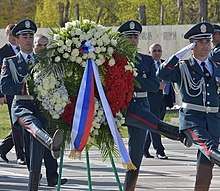 The Armenian Police Honour Guard
The Armenian Police Honour Guard
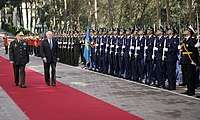 The tri-service honor guard
The tri-service honor guard- Chinese honour guard in column (Beijing Capital Garrison Honour Guard Battalion).
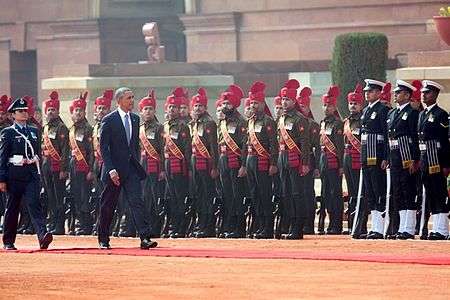
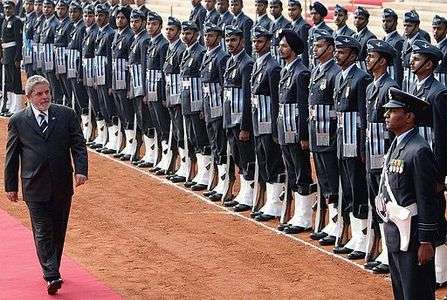 Brazilian President Lula da Silva at the Rashtrapati Bhavan receives a guard of honour ceremony from members of IAF.
Brazilian President Lula da Silva at the Rashtrapati Bhavan receives a guard of honour ceremony from members of IAF.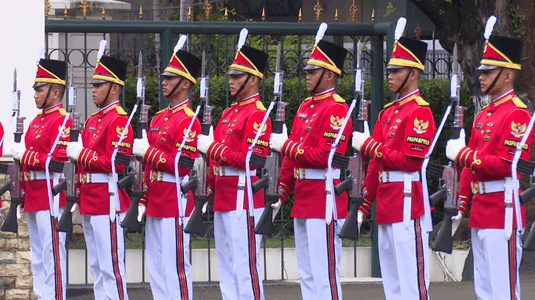 Paspampres Honour Guards of Indonesia.
Paspampres Honour Guards of Indonesia.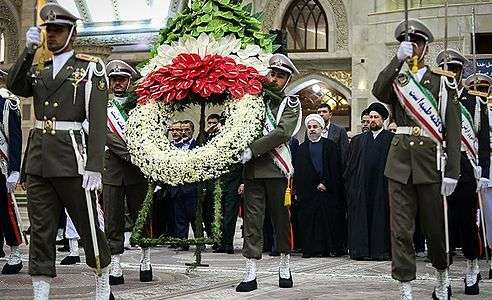 Honor guard at Mausoleum of Ruhollah Khomeini.
Honor guard at Mausoleum of Ruhollah Khomeini..jpg) Vice President Mike Pence inspecting the company during his visit to Tokyo
Vice President Mike Pence inspecting the company during his visit to Tokyo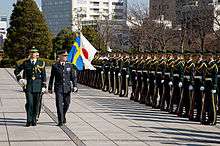 General Sverker Göranson, Supreme Commander of the Swedish Armed Forces, inspecting the company at the Japanese Ministry of Defense in Tokyo on March 2, 2015.
General Sverker Göranson, Supreme Commander of the Swedish Armed Forces, inspecting the company at the Japanese Ministry of Defense in Tokyo on March 2, 2015.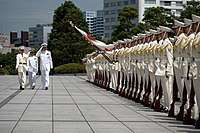 The company in 2007
The company in 2007- The Republican Guard of Kazakhstan.
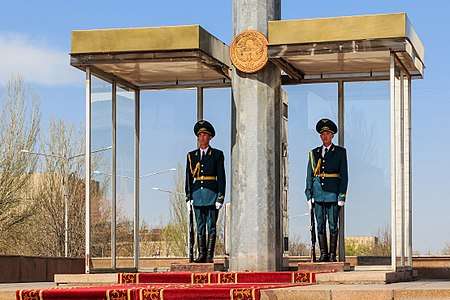 The honor guard of the National Guard standing at attention on Ala-Too Square.
The honor guard of the National Guard standing at attention on Ala-Too Square.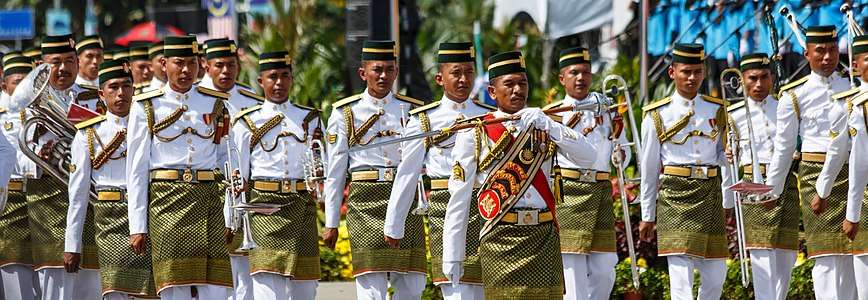 The Guard of Honour and marching band of the Royal Malay Regiment during Hari Merdeka celebrations in 2013.
The Guard of Honour and marching band of the Royal Malay Regiment during Hari Merdeka celebrations in 2013. A Pakistani Honour Guard prepares for the arrival of U.S. Defense Secretary Robert M. Gates at the Army's Martyr's Monument.
A Pakistani Honour Guard prepares for the arrival of U.S. Defense Secretary Robert M. Gates at the Army's Martyr's Monument..jpg) US Navy Admiral Mike Mullen (pictured in the center), the chairman of the US Joint Chiefs of Staff, reviewing the honour-guard of the Singapore Armed Forces during a welcoming ceremony at the Istana.
US Navy Admiral Mike Mullen (pictured in the center), the chairman of the US Joint Chiefs of Staff, reviewing the honour-guard of the Singapore Armed Forces during a welcoming ceremony at the Istana..jpg) The Korean honour guard from the 3rd Infantry Division welcomes U.S. Secretary of State John Kerry at the Seoul Airbase.
The Korean honour guard from the 3rd Infantry Division welcomes U.S. Secretary of State John Kerry at the Seoul Airbase.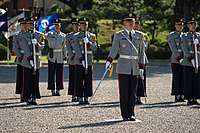 A military honour guard
A military honour guard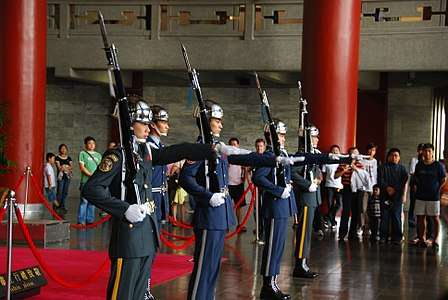 Honour guards of Republic of China (Taiwan) Armed Forces at the Sun Yat-sen Memorial Hall in Taipei.
Honour guards of Republic of China (Taiwan) Armed Forces at the Sun Yat-sen Memorial Hall in Taipei.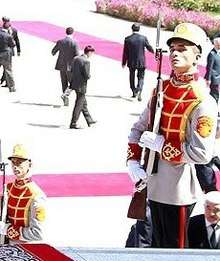 Members of the Presidential National Guard.
Members of the Presidential National Guard.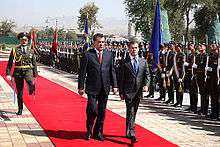 Dmitry Medvedev and Emomali Rahmon inspecting the honour guard company of the Tajik Defense Ministry.
Dmitry Medvedev and Emomali Rahmon inspecting the honour guard company of the Tajik Defense Ministry.- Turkish Presidential Guard Regiment during a parade.
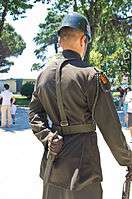
.jpg) Members of the battalion during a parade in 2011.
Members of the battalion during a parade in 2011. An Uzbek honour guard marching.
An Uzbek honour guard marching. The Ground Forces sleeve patch of the Tashkent Military District's Honour Guard Company
The Ground Forces sleeve patch of the Tashkent Military District's Honour Guard Company Indian Prime Minister Narendra Modi and Uzbek President Islam Karimov inspecting the battalion in 2016.
Indian Prime Minister Narendra Modi and Uzbek President Islam Karimov inspecting the battalion in 2016. Changing of the guards at the Ho Chi Minh Mausoleum.
Changing of the guards at the Ho Chi Minh Mausoleum.
Europe
Belarus
The Honor Guard Company of the Military Commandant's Office of the Armed Forces of Belarus is the primary honour guard company of the Republic of Belarus.
Bulgaria
National Guards Unit (Bulgarian: Национална гвардейска част), established 1878, includes military units for army salute ceremonials, a band and a wind orchestra. In 2001 the National Guards Unit was declared the official military unit representing the Bulgarian Army and one of the symbols of modern state authority along with the flag, the coat of arms and the national anthem.[22]
Croatia
In Croatia, the Honour Guard Battalion (Croatian: Počasno-zaštitna bojna) serves as the guard of honour. The Honour Guard Battalion performs protocol tasks for the needs of top-level state and military officials, as well as tasks related to the protection and security of the Commander-in-Chief (President of the Republic of Croatia). It consist of up to 300 members. The unit is under direct command of the General Staff of the Armed Forces of the Republic of Croatia.[23]
Czech Republic
Ceremonial duties are usually served by the Castle Guard, a special unit of the armed forces of the Czech Republic, organized under the Military Office of the President of the Czech Republic, directly subordinate to the President of the Republic. The Army of the Czech Republic is represented by the Honor Guard of the Czech Armed Forces (CAF Honor Guard), which was founded in 2005.[24]
The company is currently made of 38 soldiers who are organized in the following manner:
- 1 commander of unit (currently Captain Miroslav Leška)
- 3 color guard members
- 27 Honour Guard soldiers
- 4 reserves
Denmark
The Royal Life Guards is an infantry regiment of the Danish Army. It serves in two roles: as a front line combat unit, and as a guard/ceremonial unit to the Danish monarchy. Danish Amalienborg palace is guarded by this unit day and night.
France
The Republican Guard of the National Gendarmerie provides both foot and horse-mounted guards of honour.
Germany
The primary mission of the Wachbataillon is to perform the military honours for the German Federal President, Federal Chancellor, Federal Minister of Defense and the Inspector General of the Bundeswehr during state visits or on similar occasions. In addition, the Wachbataillon takes part in military events and ceremonies of major importance. A secondary mission is to perform ceremonial guard duty at the Ministry of Defense and other high-profile public places, and protect and guard the members of the German government and the Ministry of Defense.
The GDR's Friedrich Engels Guard Regiment was the primary honour guard regiment of East Germany.
Greece
In Greece, the Presidential Guard is a unit of the Greek Army guarding the Tomb of the Unknown Soldier and the Presidential Palace. Its members, known as Evzones, must be taller than 1.85m and are trained hard as their duty includes standing completely still for more than an hour 4 times a day. They are famous for their military discipline, the ability to stand motionless without even blinking, their stylish walking and the uniform which derives from traditional Greek dress.
Hungary
The Honour Guard in Hungary was the HDF 32nd Budapest Guard and Ceremonial Regiment (Hungarian: MH 32. Budapest Őr- és Díszezred) until 31 December 2006, at which time it was disbanded. From 1 January 2007 was the Ceremonial Battalion branch, part of the MH Támogató Dandár (MH TD, HDF Support Brigade) until 31 December 2010. Converted from 1 January 2011 to Nemzeti Honvéd Díszegység (National Home Defense Ceremonial Band) as part of the MH TD and achieved the service from 25 April.[25][26] The official honour guard of the Hungarian People's Republic was the Hungarian People's Army's 7015th Ceremonial Regiment (Hungarian: Magyar Néphadsereg 7015 Dísz -és őrezred).[27][28][29]
Ireland
In Ireland, a guard of honour is drawn from the Irish Army and is called 'Garda Onóra' in Irish. It is inspected by the President of Ireland, Taoiseach or visiting dignitaries.
Italy
In Italy the unit institutionally intended to act as an honour guard to the President of the Italian Republic is the Corazzieri Regiment, a special branch of the Carabinieri.[30] The Corazzieri follow the President during official occasions and are also partly responsible for the internal security of the Quirinal Palace. In addition to the Corazzieri, there are other honour units chosen from the different Armed Forces, specifically for representation purposes. These units have to stand guard at important places, such as the gates of the seats of the Chamber of Deputies and the Senate, at the Tomb of the Unknown Soldier in the Altar of the Homeland, and at the gates of the Quirinal Palace.
Example of honour units from the different Armed Forces are:
- Italian Army:
- Honour Company "Goito" from the 1° Regiment "Granatieri di Sardegna";
- Honour Squadron from the 8° Regiment "Lancieri di Montebello";
- Italian Navy:
- Italian Air Force:
During state funerals, honour guards are granted to the departed by the protocol.[31] The guards are positioned at the entrance and the exit of the place in which the ceremony is held. Aside from the aforementioned services, honour guards are also found within the Guardia di Finanza, Polizia Penitenziaria and the Polizia di Stato. They perform the same duties mentioned above.
Macedonia
The Ceremonial Guard Battalion (Церемонијален гардански баталјон, Ceremonijalen gardanski bataljon) is part of the Army of the Republic of Macedonia which is mainly used for ceremonial purposes. It is the personal guard of the President of the Republic of Macedonia. The National Guard can be often seen near the presidential palace, during official visits of foreign presidents or delegations, ceremonies and during the days of the flag. In 2010 the Ministry of Defence proposed and designed new uniforms for the guards. Both, the old and the new uniforms, are based on the uniforms of the Internal Macedonian Revolutionary Organization (IMRO) revolutionaries with some details of the other periods of the history of the Republic of Macedonia. Influence over the new design were based on the uniform worn by Bulgarian[32][33][34] revolutionary Dedo Iljo Maleshevski and the uniforms of the 19th century Bulgarian Legion regiment which served in the Imperial Russian Army.[35]
Netherlands
The Honour Guards in Netherlands consists of two guard regiments, Garderegiment Grenadiers en Jagers & Garderegiment Fuseliers Prinses Irene, both from the Royal Netherlands Army.
Guard of honor detachments for public duties are present in the Royal Netherlands Navy and the Royal Netherlands Air Force.
Norway
Poland
The Honour Guard unit in Poland is the Pulk Reprezentacyjny Wojska Polskiego (Representative Honour Guard Regiment of the Polish Armed Forces), created on 30 March 2018 on the basis of the Representative Honor Guard Battalion.[36]
Also posted within its ranks is the Presidential Mounted Ceremonial Troop of the Armed Forces, which also acts as an honour guard and horse guard unit. Service branches of the Armed Forces, the Warsaw Garrison and other civil uniformed services all maintain honour guard units of their own.
Romania
The Brigada 30 Gardă „Mihai Viteazul” (Michael the Brave 30th Guards Brigade) of the Romanian Land Forces serves as the honour guard brigade of the Romanian Armed Forces. The brigade is present at ceremonial events and during visits from international officials. The Romanian Gendarmerie maintains an honour guard unit, called Unitatea Specială de Gardă de Onoare și Protecție Instituțională București (Bucharest Institutional Protection and Honour Guard Special Unit), and a horse guards troop acting during state ceremonies and celebrations of the service. From 1947-1989, ceremonial duties were provided by the Garda de Onoare a Armatei Populare Române (Honor Guard Unit of the Romanian People's Army), which was a unit of company size.
Russia
Russia's primary honour guard (Russian: Почётный караул, Pochotny kara-ul) is the Kremlin Regiment of the Federal Protective Service of the Russian Federation, established in 1936. The 154th Preobrazhensky Independent Commandant's Regiment, established in 1979, serves as the official representative honour guard regiment of the Russian Armed Forces and serves as the main honour guard unit of the armed forces.
Military districts and fleet formations of the Russian Navy also have their own honour guard companies. Examples of honour units from all three branches of the Armed Forces include:
- Russian Ground Forces:
- Honour Guard Company of the Western Military District - It was formed on 20 January 1961 by the order of the Commander of the Leningrad Military District. In 1983, it was put under the command of the 165th Separate Rifle Company. It is based in St. Petersburg.[37][38][39][40][41]
- Honour Guard Company of the Central Military District
- Honour Guard Company of the Southern Military District
- Honour Guard Company of the Eastern Military District - It was formed on 14 December 1971 and is currently led by Lieutenant Colonel Dmitri Zielinski[42][43]
- Volgograd Honour Guard
- Russian Navy:
- Honour Guard Company of the Northern Fleet
- Honour Guard Company of the Black Sea Fleet
- Honour Guard Company of the Pacific Fleet
- Honour Guard Company of the Baltic Fleet
- Russian Air Force:
- Honour Guard Company of the Russian Air Force
- Other agencies:
- Honour Guard Company of the EMERCOM
The Russian Imperial Guards served as honour guards for the Russian Empire.
Serbia
The Serbian Guards Unit is an elite unit within the Serbian Army, of brigade size, under the direct command of Serbian Armed Forces Chief of Staff. Its purpose to secure vital facilities of the defense system and performing military honours to highest foreign, domestic and military officials.
For the needs of Ministry of Defence and the Serbian Army General Staff, the Guard Unit performs tasks within the scope of the military police work and the tasks in the field of logistics and security. Guard continues the tradition of Serbian Guard units which is now almost two centuries long. The first Guard unit formed in Serbia was created on the order of Prince Milos Obrenovic on St. George Day in 1830 in Pozarevac. The Guard Unit also sports the official military band of the Serbian Armed Forces - the Guards Band.
Spain
On top of bodyguard services & overseas deployment, the Spanish Royal Guard (Guardia Real) also perform ceremonial & honor guard services.
Sweden
Honour guard service is carried out by all units of the Swedish Armed Forces, although the Life Guards Regiment (Livgardet) in the Swedish Army accounts for the main part of honour guard services. The Royal Guards (Högvakten) at the Stockholm Palace and the Drottningholm Palace is the honour guard to the King of Sweden. The service is carried out by the Life Guards as well as other units of the Swedish Armed Forces including the Home Guard and other voluntary defence organisations.[44]
The Grenadier company of the Life Guards is used as an honour guard at state visit welcoming ceremonies. A detachment of grenadiers is also used as honour guard at the opening of the Riksdag, when an incoming foreign ambassador meets with the King at an audience to present letters of credence and when the King attends an annual meeting of one of the Royal Academies.[45]
Drabantvakt ("Royal Bodyguard"), commonly known as Karl XI:s drabanter ("The Bodyguard of Charles XI") and Karl XII:s drabanter ("The Bodyguard of Charles XII") is a ceremonial guard used at state occasions such as state visits, investiture of a monarch, royal weddings and funerals etc. The guard was formed in 1860 based on historical royal bodyguards. The design of the uniforms of the guard is based on, but not identical to, uniforms used during the reign of Carles XI and Charles XII respectively. The guard consists of 24 soldiers and one officer selected from the Life Guards.[46]
United Kingdom
A guard of honour is formed to present formal ceremonial compliments to royal or presidential dignitaries by a guard not exceeding 100 personnel (including three officers, one with a colour) with other particular distinguished individuals saluted by a guard not exceeding 50 personnel. A half guard is a colloquial term describing a guard of honour of not more than 50 personnel (including two officers, one with a colour).[47] A guard of honour could have a single service contingent (e.g. army) or it could be a tri service (inter-service) affair. The guard commander, after saluting the dignitary (usually head of state), marches up to him or her and escorts him or her to inspect the guard (soldiers in formation). During the salute, the national anthems of both the dignitary's country and the host country are usually played by a ceremonial band.
Only a standard, guidon, Queen's Colour, or a banner presented by either a member of the Royal Family or the governor-general may be carried by a royal guard of honour. Only a regimental colour or a banner presented by a personage other than a member of the Royal Family may be carried on a half guard of honour. A smaller unit honouring distinguished visitors at a military installation is known as a quarter guard. The commander is three paces in front of the second file from the right and accompanies the personage for whom the guard is mounted. An officer carrying the Colour stands three paces in front of the centre; if there is a third officer he will be three paces in front of the second file from the other flank.[48]
Units that traditionally perform ceremonial duties, such as Guard Mounting (changing of the Queen's Guard) or Trooping the Colour, are the five regiments of Foot Guards and the Household Cavalry (Blues and Royals and Life Guards), which form the Household Division. The Royal Air Force's ceremonial unit is the Queen's Colour Squadron. The British Armed Forces do not have dedicated ceremonial units, although some units such as the Scots Guards have a battalion designated to perform public duties. Generally, units from all three services not deployed overseas will rotate and share public duties at various major historic landmarks (e.g. royal palaces and castles) through the country.
The Queen's Guard is primarily made up of units from the Household Division for royal palaces and public monuments—namely Buckingham Palace, St James's Palace, Windsor Castle, and the Tower of London—and other units from all three services of the British Armed Forces filling in when not deployed; in Scotland, Holyrood Palace and Edinburgh Castle are usually the responsibility of Scottish regiments or units based in Edinburgh.[49] Occasionally units from Commonwealth militaries are given the honour.[50]
Ukraine
The Kyiv Presidential Honor Guard Battalion is a guard of honour unit of the Armed Forces of Ukraine, which is Hetman Bohdan Khmelnytsky Independent Presidential Guard Regiment.[51] The National Guard of Ukraine uses the NGU National Honor Guard Battalion for ceremonial activities, which was also in service before the disbandment of the Internal Troops of Ukraine.
Gallery of Europe
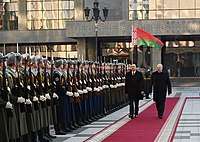 The Honor Guard of the Armed Forces of Belarus during the welcoming ceremony in honor of the visiting President of Azerbaijan November 2015.
The Honor Guard of the Armed Forces of Belarus during the welcoming ceremony in honor of the visiting President of Azerbaijan November 2015.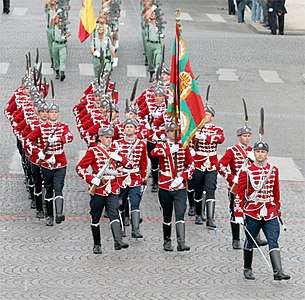 National Guards Unit of Bulgaria marching during the Bastille Day Military Parade 2007 in Paris.
National Guards Unit of Bulgaria marching during the Bastille Day Military Parade 2007 in Paris. Ceremonial dress of the Honour Guard Battalion of the Croatian Armed Forces.
Ceremonial dress of the Honour Guard Battalion of the Croatian Armed Forces.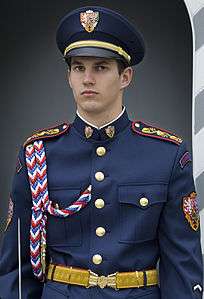 A member of Czech Castle Guard.
A member of Czech Castle Guard..jpg) A color guard from the Honor Guard of the Czech Armed Forces.
A color guard from the Honor Guard of the Czech Armed Forces.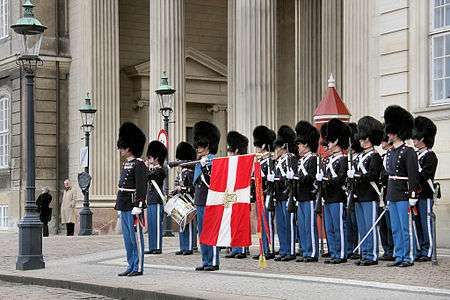 Danish Royal Guards presenting arms at the Changing of the Guard ceremony, Amalienborg, Copenhagen.
Danish Royal Guards presenting arms at the Changing of the Guard ceremony, Amalienborg, Copenhagen.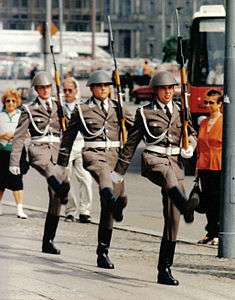
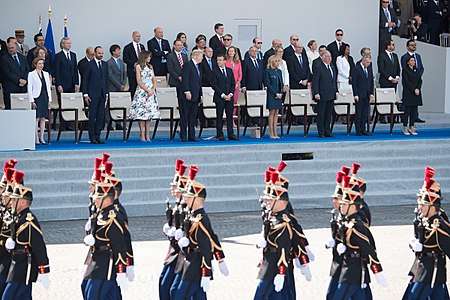 The Republican Guard marching during a Bastille Day Parade in Paris in 2017.
The Republican Guard marching during a Bastille Day Parade in Paris in 2017. The French Republican Guard guarding the presidential palace.
The French Republican Guard guarding the presidential palace..jpg) The Slovenian Prime Minister Alenka Bratušek inspecting a in Germany guard of honor together with German Chancellor Angela Merkel, in 2013.
The Slovenian Prime Minister Alenka Bratušek inspecting a in Germany guard of honor together with German Chancellor Angela Merkel, in 2013.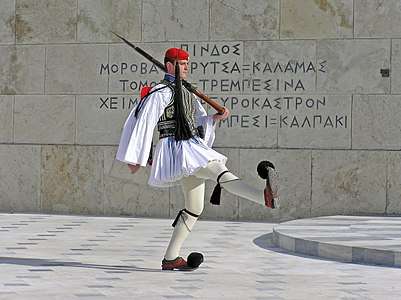 The Presidential Guard.
The Presidential Guard.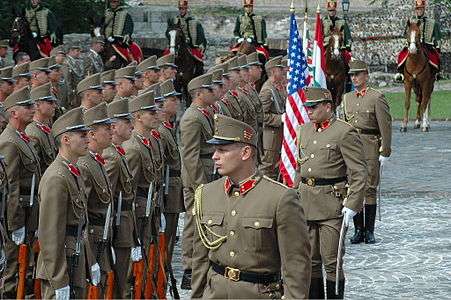 The MH 32. Budapest Őr- és Díszezred welcome the President of the United States on 22 June 2006. Mounted hussars can be seen along the top.
The MH 32. Budapest Őr- és Díszezred welcome the President of the United States on 22 June 2006. Mounted hussars can be seen along the top.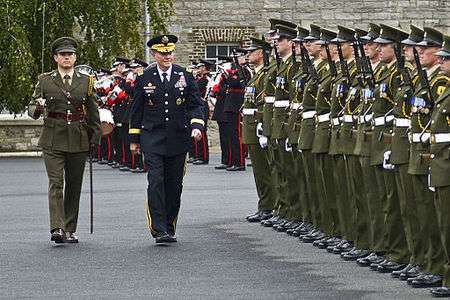 Gen. Martin E. Dempsey, chairman of the Joint Chiefs of Staff, reviews the Irish Honor Guard at Brugha Barracks in Dublin, Aug. 31, 2012.
Gen. Martin E. Dempsey, chairman of the Joint Chiefs of Staff, reviews the Irish Honor Guard at Brugha Barracks in Dublin, Aug. 31, 2012. Italian Corazzieri on parade, in high uniform and riding horses.
Italian Corazzieri on parade, in high uniform and riding horses.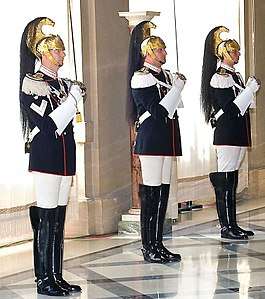 Corazzieri in the Quirinal palace.
Corazzieri in the Quirinal palace.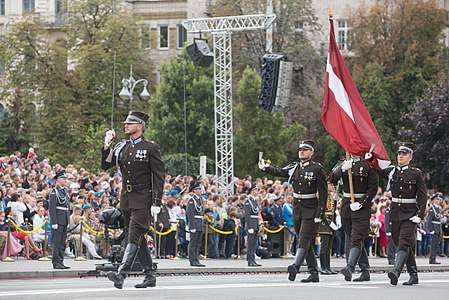 The troops of the Latvian National Armed Forces Staff Battalion during the 2017 Kiev Independence Day Parade.
The troops of the Latvian National Armed Forces Staff Battalion during the 2017 Kiev Independence Day Parade.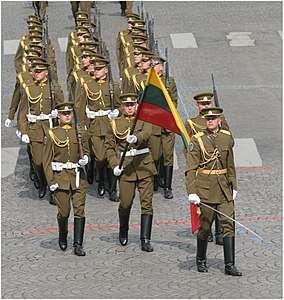 The honor guard company during the 2007 Bastille Day Parade.
The honor guard company during the 2007 Bastille Day Parade. A member of the Ceremonial Guard Battalion (in the middle). The soldier wears the old uniform.
A member of the Ceremonial Guard Battalion (in the middle). The soldier wears the old uniform.- Carabinier at the Prince's Palace in Monaco-Ville.
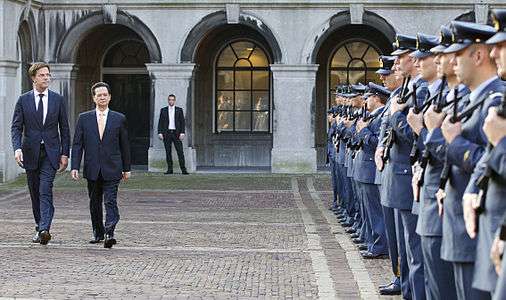
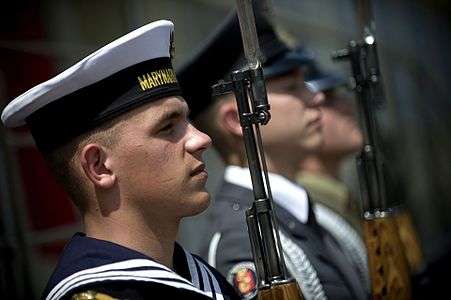
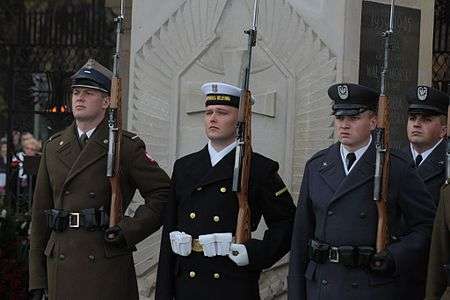
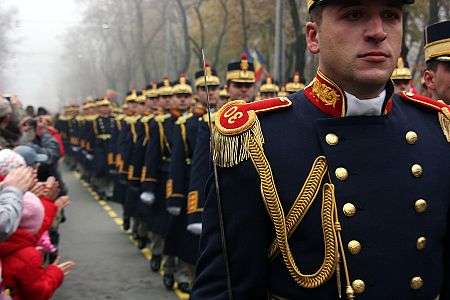 Romanian 30th Guard Regiment on parade during 1 December celebrations.
Romanian 30th Guard Regiment on parade during 1 December celebrations.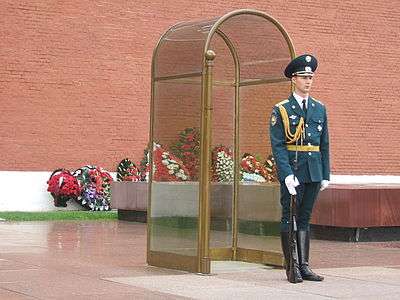 A guard at the Tomb of the Unknown Soldier (Moscow).
A guard at the Tomb of the Unknown Soldier (Moscow).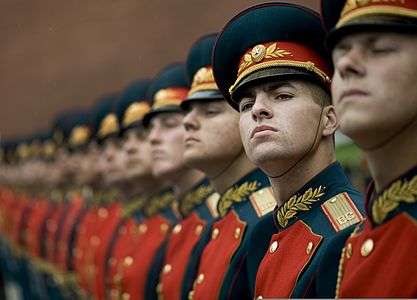 The Russian military honour guard from the 154th Commandant's Regiment welcomes U.S. Navy Adm. Mike Mullen at the Tomb of the Unknown Soldier.
The Russian military honour guard from the 154th Commandant's Regiment welcomes U.S. Navy Adm. Mike Mullen at the Tomb of the Unknown Soldier.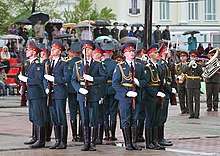 The Khabarovsk Honour Guard in 2017.
The Khabarovsk Honour Guard in 2017.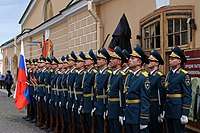 Honour Guard Company of the EMERCOM
Honour Guard Company of the EMERCOM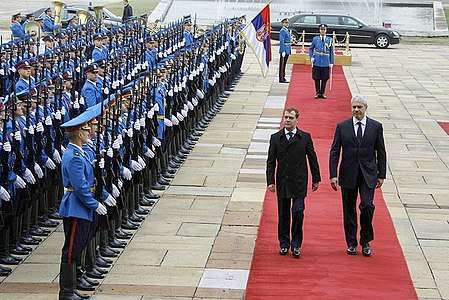
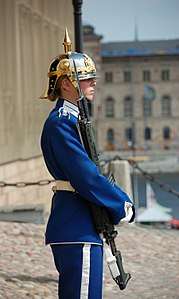 A dragoon of the Life Guards Regiment posted outside the Stockholm Palace.
A dragoon of the Life Guards Regiment posted outside the Stockholm Palace.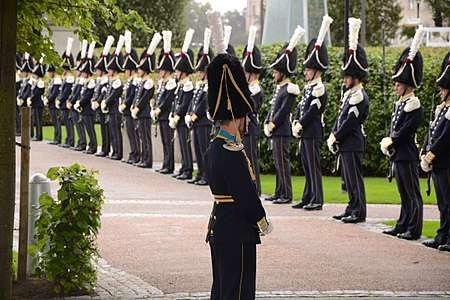 Grenadiers of the Life Guards Regiment forming a guard of honour at the opening of the Riksdag.
Grenadiers of the Life Guards Regiment forming a guard of honour at the opening of the Riksdag.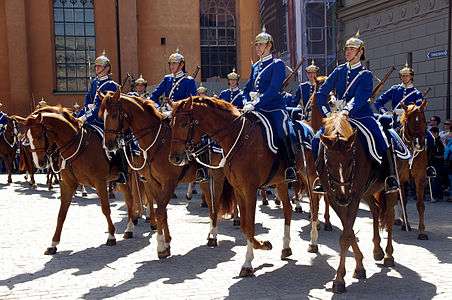 The Life Guards Regiment mounting the Royal Guards at the Stockholm Palace.
The Life Guards Regiment mounting the Royal Guards at the Stockholm Palace.- A sentry from an armoured regiment on guard outside the Stockholm Palace.
- A sentry at Buckingham Palace.
- Coldstream Guards performing the guard change at Windsor Castle.
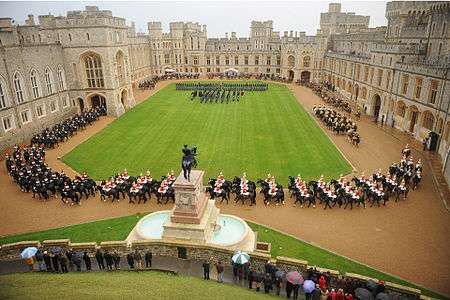 Household Cavalry parading at Windsor Castle for the state visit of the Amir of Kuwait to the United Kingdom in 2012.
Household Cavalry parading at Windsor Castle for the state visit of the Amir of Kuwait to the United Kingdom in 2012.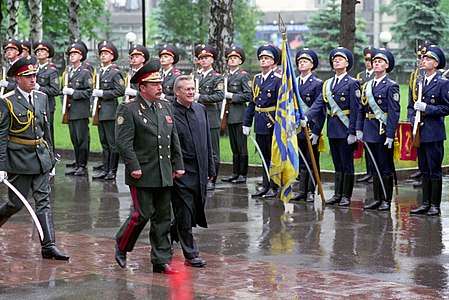 Ukrainian Minister of Defense, Oleksandr Kuzmuk, and US Secretary of Defense Donald H. Rumsfeld inspect the Ukrainian Guard of Honor in Kiev.
Ukrainian Minister of Defense, Oleksandr Kuzmuk, and US Secretary of Defense Donald H. Rumsfeld inspect the Ukrainian Guard of Honor in Kiev.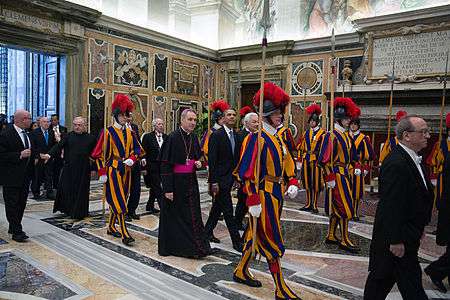 An detachment of the Pontifical Swiss Guard escorting U.S. President Barack Obama to an audience with Pope Francis in 2014.
An detachment of the Pontifical Swiss Guard escorting U.S. President Barack Obama to an audience with Pope Francis in 2014.
Oceania
Australia
The tri-service Federation Guard, consisting of members of the Australian Army, the Royal Australian Air Force and the Royal Australian Navy provides guards of honour for various ceremonies. All members of the guard are enlisted in their respective areas before volunteering for service in the guard. The rifle of choice is the L1A1 SLR.
Gallery of Oceania
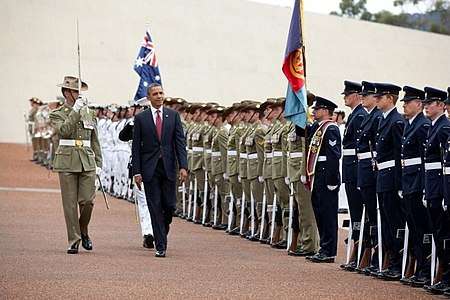
 The Republic of Fiji Military Forces Quarter Guard
The Republic of Fiji Military Forces Quarter Guard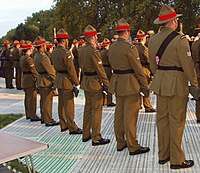 New Zealand Army Honour Guard
New Zealand Army Honour Guard
Sports
Cricket
In cricket, the guard of honour is used to celebrate the achievement of a player (usually as a batsman), normally used during a player's final game. The players' teammates or opposition form a cordon, with their bats at the second count of the draw saber forming an arch, and the successful player walks through. It may also be performed to mark a milestone, such as when a player breaks a world record. A player can receive guard of honour multiple times as they retire from different forms of the game separately. When a bowler retires, it would generally be when they leave the field for the final time, or when they play their final match in a certain venue of importance (away match, home ground, retiring on the same day a ground is due to be demolished).
Association football
In recent years, association football teams have shown their respect to teams in their own division which have already won their league title at the end of the season with games to spare by forming a guard of honour onto or off the pitch for their players.[52] The applauding team forms two lines to make a corridor and the league winners pass through the corridor, generally in single file. The guard of honour is in some instances considered good form to perform but is not considered compulsory and teams may opt not to provide one, as especially tends to happen between teams considered particularly bitter rivals.[53]
The same has occasionally been done for individual players meeting particularly momentous points in their career, such as when Scottish Premier league team Rangers squad did so for departing talisman Dado Prso[54] and Chelsea controversially[55] chose to do so in a pre-planned display in the middle of a match for John Terry's last game, causing significant delays to the game.[55]
Australian rules football
In Australian rules football, players will often form a guard of honour for those who are leaving the field after a landmark game or on their retirement game. For example, Fremantle formed a guard of honour for Fitzroy's last match in 1996. Melbourne and Essendon formed a guard in 2005 to honour Indian Ocean tsunami victim Troy Broadbridge. Collingwood and North Melbourne formed a guard of honour in 2006 for retiring player Saverio Rocca, who forged a successful goalkicking career at both clubs. After playing in the little league at half time of senior matches, the junior players line up to form a guard of honour for when the players return to the field.[56]
Field Hockey
In recent times guard of honour is usually done among Hockey players for those who have done something valuable for their country like Balbir Singh, Sr, Jamie Dwyer
See also
References
- ↑ Traditions of the United Methodist Church
- ↑ "State President's Unit". South African National Defence Force.
- ↑ "The Canadian Armed Forces Ceremonial Guard". Queen's Printer for Canada. 24 June 2016. Retrieved 28 May 2017.
- ↑ "About the Ceremonial Guard". Queen's Printer for Canada. 2017. Archived from the original on 16 September 2014. Retrieved 28 May 2017.
- ↑ About the 3d U.S. Infantry Regiment, U.S. Army Official website; accessed 19 January 2017
- ↑ Marine Barracks Washington, D.C. 8th & I, U.S. Marine Corps Official Website; accessed 19 January 2017
- ↑ U.S. Navy Ceremonial Guard, U.S. Navy Official Website; accessed 19 January 2017
- ↑ U.S. Air Force Honor Guard, U.S. Air Force Official Website; accessed 19 January 2017
- ↑ U.S. Coast Guard Ceremonial Honor Guard, U.S. Coast Guard Official Website; accessed 19 January 2017
- ↑ About the 3d U.S. Infantry Regiment, U.S. Army Official Website; accessed 19 January 2017
- ↑ Tomb of the Unknown Soldier, HHC, 4th Battalion, 3d U.S. Infantry Regiment, U.S. Army Official Website; accessed 19 January 2017
- ↑ Manager, Micrositios Content. "Batallón de Infantería No. 37 Guardia Presidencial - DIV05". Ejército Nacional de Colombia.
- ↑ Peri, Dinakar (26 January 2015). "Pooja Thakur makes history". Retrieved 30 September 2018 – via www.thehindu.com.
- ↑ Sputnik. "Нацгвардия КР снимает почетный караул у флагштока на площади Ала-Тоо". ru.sputnik.kg (in Russian). Retrieved 2017-12-03.
- ↑ "Почетный караул на страже поста №1 на площади Ала-Тоо". m.ru.sputnik.kg. Retrieved 30 September 2018.
- ↑ "Royal Guard-Changing Ceremony - Korea Cultural Heritage Foundation". www.chf.or.kr. Retrieved 30 September 2018.
- ↑ CNN, Faith Karimi and Isil Sariyucem. "Turkey to disband elite presidential guard unit". CNN. Retrieved 2016-09-24.
- ↑ Праздничный парад открывает знамённая группа. Воины Отдельного батальона Почётного караула под звуки торжественного марша проносят по площади Государственный флаг Туркменистана и боевые знамена всех родов войск. Source: http://www.parahat.info/news/parahat-info-news-14928
- ↑ tepfair (15 November 2009). "Ashgabat, Turkmenistan 05 - Changing of the Guards" – via YouTube.
- ↑ Unit of Military Honour Guard; accessed 7 July 2015. (in Vietnamese)
- ↑ Ho Chi Minh Mausoleum Honour Guard; accessed 7 July 2015. (in Vietnamese)
- ↑ President of the Republic of Bulgaria, Official Website, National Guards Unit; accessed 28 February 2016.
- ↑ Dugoročni plan razvoja Oružanih snaga Republike Hrvatske za razdoblje 2015. do 2024. godine (Long-Term Development Plan of the Croatian Armed Forces for the period 2015-2024) (in Croatian)
- ↑ The Honour Guard of the Armed Forces of the Czech Republic
- ↑ "Búcsúztak a harminckettesek - Jobbik.NET". www.jobbik.net.
- ↑ "MH Támogató Dandár" (in Hungarian). parbeszed.hm.gov.hu. Retrieved 7 July 2015.
- ↑ "32. Nemzeti Honvéd Díszegység". Retrieved 30 September 2018.
- ↑ "Rendszerváltás után :: Harminckettesek Baráti Köre". m.harminckettesek.webnode.hu. Retrieved 30 September 2018.
- ↑ "MH vitéz Szurmay Sándor Budapest Helyőrség Dandár". Retrieved 30 September 2018.
- ↑ "The Corazzieri, the Italian Corps of Cuirassiers". The official website of the Presidential Palace.
- ↑ "Protocol for State Funerals and National Mourning". Official website of the Italian Government – Department of State Ceremonies.
- ↑ MacDermott, Mercia (1988). "For freedom and perfection. The Life of Yané Sandansky". London: Journeyman. p. 21.
- ↑ Ethnic rivalry and the quest for Macedonia, 1870-1913, Vemund Aarbakke, East European Monographs, 2003, p. 56, ISBN 0-88033-527-0
- ↑ Freedom or death, the life of Gotsé Delchev, Mercia MacDermott, Journeyman Press, 1978, p. 39, p 54. ISBN 0-904526-32-1
- ↑ Презентирани нови гардиски униформи- микс на Армани и дедо Иљо Малешевски; accessed 8 July 2015.(in Macedonian)
- ↑ Batalion Reprezentacyjny Wojska Polskiego (Polish language wikiarticle)
- ↑ Мальцев, Александр. "50 лет Роте Почетного караула Санкт-Петербурга". sc.spbu.ru. Retrieved 30 September 2018.
- ↑ "Роте почетного караула Западного военного округа – 50 лет : Министерство обороны Российской Федерации". function.mil.ru. Retrieved 30 September 2018.
- ↑ "Роте Почетного караула батальона охраны ЗВО — 55 лет : Министерство обороны Российской Федерации". function.mil.ru. Retrieved 30 September 2018.
- ↑ "165 ОТДЕЛЬНАЯ СТРЕЛКОВАЯ РОТА ПОЧЕТНОГО КАРАУЛА ЛЕНИНГРАДСКОГО ВОЕННОГО ОКРУГА (РОТА ПОЧЕТНОГО КАРАУЛА ЗАПАДНОГО ВОЕННОГО ОКРУГА - в/ч 55338)". m.vk.com. Retrieved 30 September 2018.
- ↑ "БЕЗ ЦЕРЕМОНИЙ ЭТИМ СОЛДАТАМ НИКАК НЕ ОБОЙТИСЬ - Невское время". nvspb.ru. Retrieved 30 September 2018.
- ↑ "Рота почетного караула - Лучшее в Хабаровске". www.bestmagazine.ru. Retrieved 30 September 2018.
- ↑ "Законодательство Хабаровского края: Постановление Администрации города Хабаровска от 09.10.2015 N 3490". mbpolyakov.ru. Retrieved 30 September 2018.
- ↑ Instruktion för Försvarsmakten, Ceremonier 2010. Försvarsmakten, 2010, p. 92.
- ↑ Instruktion för Försvarsmakten, Ceremonier 2010. Försvarsmakten, 2010.
- ↑ Instruktion för Försvarsmakten, Ceremonier 2010. Försvarsmakten, 2010, p. 308–312.
- ↑ RAF Drill and Ceremonial AP 818 7th Edition
- ↑ p.128 Guards of honour from Ceremonial 1912
- ↑ The Queen's Guard – British Army website
- ↑ "Navy News – On guard". Department of Defence. 7 August 2000.
- ↑ "У військах відзначили ювілей Почесної варти МІНОБОРОНИ УКРАЇНИ, створеної 1962 року в СРСР". 10 November 2017.
- ↑ "ON GUARD What is a guard of honour and do Watford have to give one to champions Chelsea?". The Sun. 15 May 2017. Retrieved 29 December 2017.
- ↑ "Hibernian will not grant Hearts a guard of honour". Edinburgh News. 10 April 2015. Retrieved 29 December 2017.
- ↑ "Football: TEARIO DADO; Prso breaks down as Gers stars give him an emotional send-off". Daily Record. 14 May 2007. Retrieved 29 December 2017.
- 1 2 "John Terry's 26th-minute guard of honour send-off at Chelsea: fair or farce?". The Guardian. 22 May 2017. Retrieved 29 December 2017.
- ↑ Pedler, Emma (30 July 2013). "Port Power missed our guard of honour".